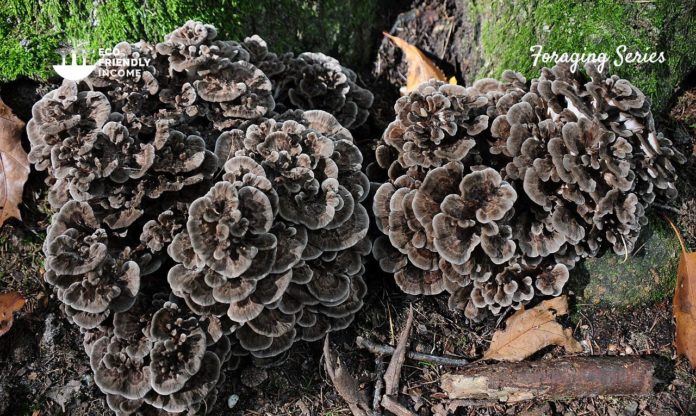Learning how to identify hen-of-the-wood is pretty easy, and once you do, you’ll have another mushroom in your arsenal to bring back home.
Once you find these mushrooms, you’ll probably have so much you won’t know what to do with them. Hen-of-the-woods almost always spawns in bulky colonies.
Also known as maitake in Japan, it’s been cultivated there for hundreds of years. For them, it’s a medicinal food that’s used to treat almost everything that ails them. From allergies to graying hair, we’ll find out the true medicinal uses of this mushroom.
I’ve been a tree planter for many years now, so naturally, I’ve had the opportunity to see hen-of-the-woods numerous times. It always fascinates me to see them in hefty colonies, I just can’t help but stop a second to admire them.
I think any mushroom lover should go hunt for them, so I decided to share my knowledge and teach you how to identify hen-of-the-woods mushrooms.
In this guide, you can expect to learn the following:
- Their Picking Season
- How to Identify Hen-of-the-Wood
- Where to Find Them
- What They Taste Like
- How to Store, Clean and Cook Them
Let’s get started!
The Hen-of-the-Wood Picking Season
Hen-of-the-Wood (Grifola frondosa) is a fall fruiting mushroom. You can find it from late August to late November.

This mushroom starts to fruit later in the season when the temperatures are cooling down.
Factors like rainfall and weather also affect when hen-of-the-woods start to fruit. A good week of rain is always beneficial for any mushroom to spawn.
Even a warm spell mid-winter could trigger them to fruit if you are south enough.
How to Identify Hen-of-the-Wood
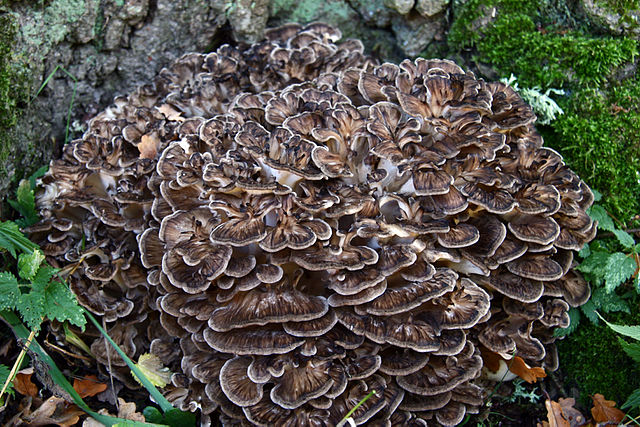
Photo by Caspar S / CC BY-2.0 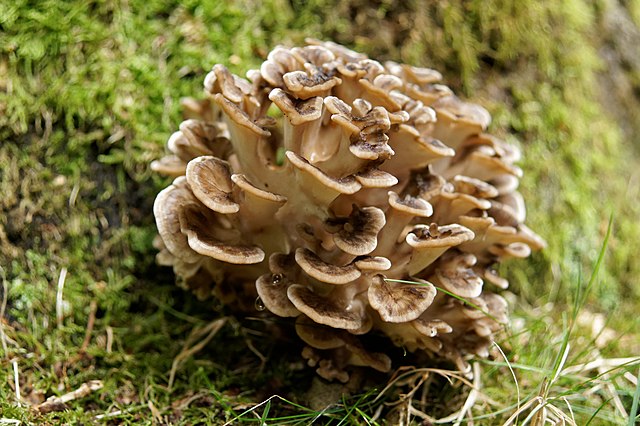
Photo by Lucas / CC BY-SA 2.0
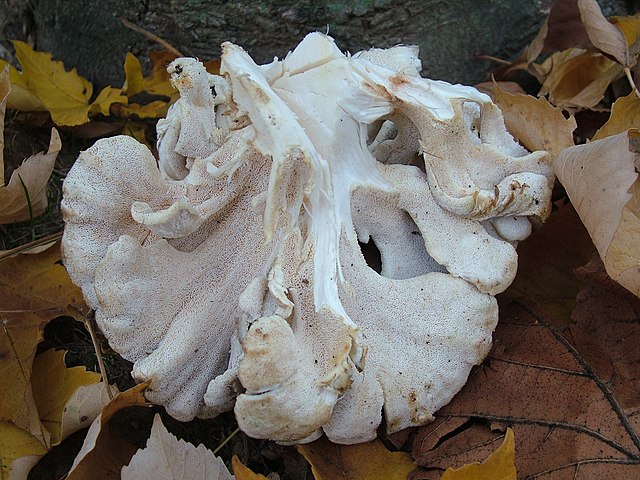
Photo by Sinisa Radic / CC-BY SA 4.0 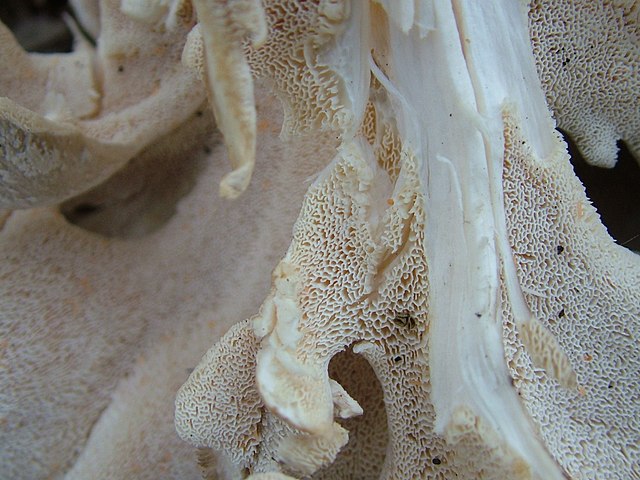
Photo by Sinisa Rardic / CC BY-SA 4.0
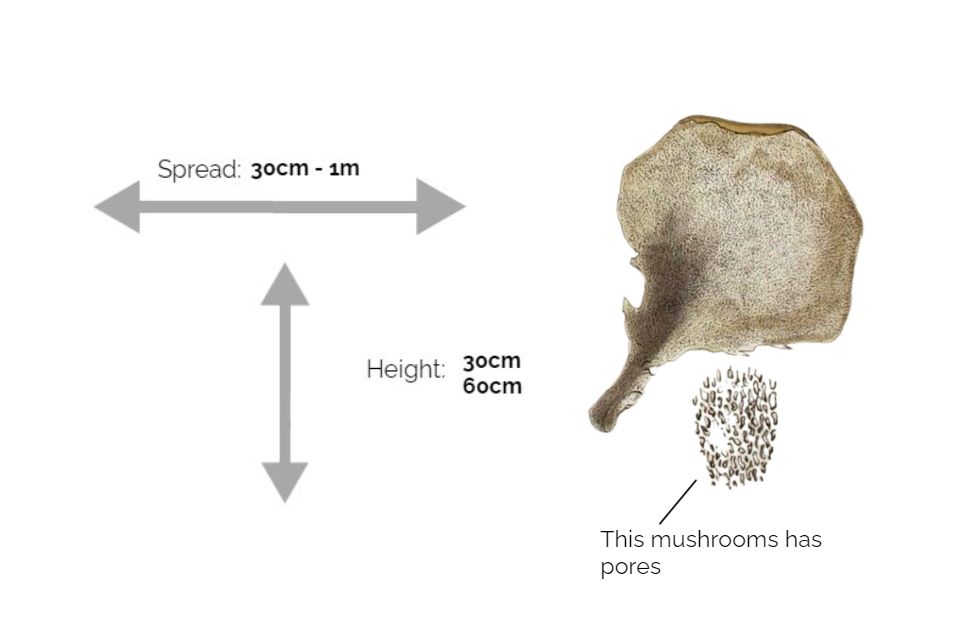
Hen-of-the-Woods are a species of parasitic mushrooms, which means they usually need a host to grow. Their shape and color along with the way they grow is reminiscent of a hen’s feathers, hence the name.
The majority of hen-of-the-wood mushrooms you’ll find will be growing at the base of a tree, especially oaks.
The color of their caps ranges from brown, light brown, to gray. Their undersides are porous and ivory white.
The individual mushrooms grow into a fan shape, and the large bundles usually have a thick trunk. When you cut a bundle in half, you’ll see something resembling a cut cauliflower.
Additionally, if you look closely, you’ll see their undersides have pores spread out in a maze pattern.
They rarely spawn alone, most commonly seen as clumps of mushrooms growing on top of another.
Another possible way to identify hen-of-the-wood is by their scent. Some people say they have a woodsy scent, others say it smells like beer or smelly socks.
Hen-of-the-Wood Mushroom Lookalikes
There are some hen-of-the-woods lookalikes. Below are a few of the most likely you are to encounter. Let’s look at how you can tell them apart:
Black Staining Polypore (Meripilus sumstinei)
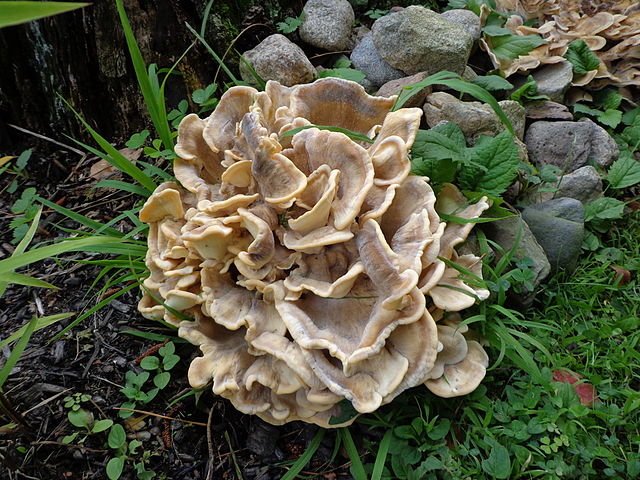
Photo by Clyde Elledge / CC BY-SA 3.0 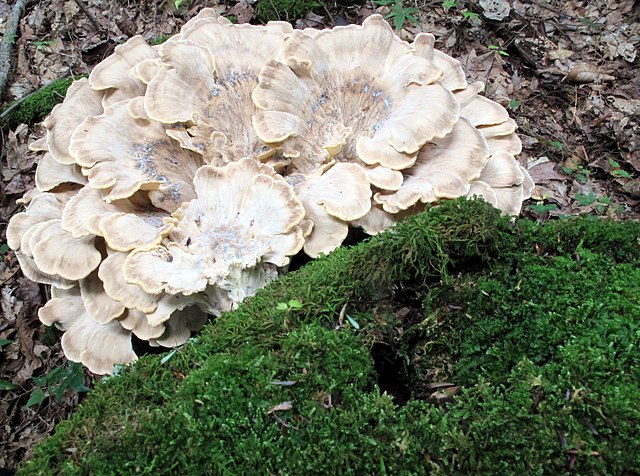
Photo by Walt Sturgeon / CC BY-SA 3.0
How to tell black staining polypore apart from hen-of-the-wood mushrooms:
- Color: Black staining polypores bruise black when cut or crushed, usually within 20 mins. They also turn black while cooking or aging while Hen-of-the-woods won’t bruise black to that extent.
- The underside: If you take a close look at the underside of a black staining polypore, they are smoother and their pores are very small. Hen-of-the-woods pores are shaped differently, like a maze pattern.
- The texture: As they get older, black staining polypores get quite tough and stringy, they’ll even be hard to pull apart by hand.
Note: Still edible, although better when young.
The Umbrella Polypore (Polyporus umbellatus)
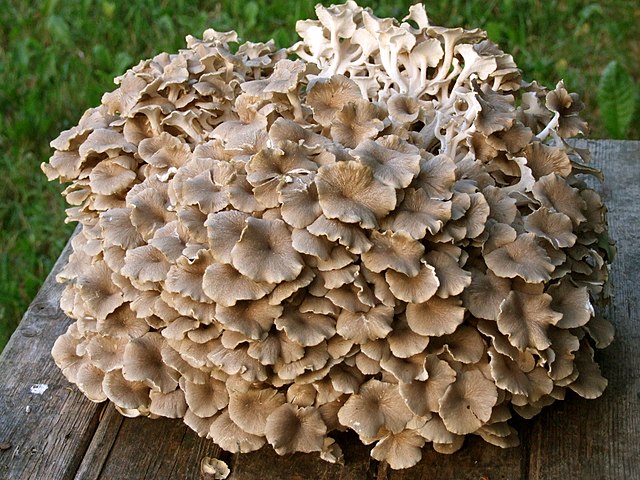
Photo by N174 / CC BY-SA 3.0 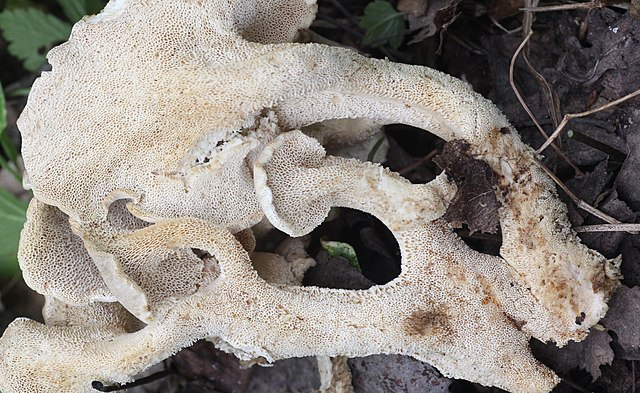
Photo by Nina Filippova / CC BY-4.0
Here’s how you can tell umbrella polypores apart from hen-of-the-woods:
- The color: Umbrella polypores are noticeable lighter in color than hen-of-the-woods.
- Its growth season: They are more of a summer and early autumn mushroom while hen-of-the-woods appears more later in the season.
- The shape: If you look closely at the mushroom caps, you’ll notice that umbrella polypores are round and umbrella shaped, while hen-of- the-woods has more of a fan shape.
Note: Umbrella polypores are just as edible as hen-of-the-woods.
Where You Can Find Hen-of-the-Wood
Hen-of-the-wood mushrooms associate most often with oak trees, which means oak-rich forests are great fruiting grounds.
Since they are parasitic, you will find them growing near diseased or weaker trees. They latch on to dying or decomposing roots and pull nutrients from them.
Other good spots to look for hen-of-the-wood mushrooms are river banks near maple trees.
An important point to remember: They don’t grow directly on the trunk or branches, but rather at the base of trees on the soil.
What They Taste Like
When freshly picked and cooked, hen-of-the-wood flavor is earthy, yet peppery. It can pull flavor from ingredients you add while cooking.
The best part about them is the texture. They have a soft yet chewy texture that makes them a pleasant addition to your favorite dishes.
How to Store, Clean & Cook Hen-of-the-Wood
How to Store Them
Storing them correctly is important to keep them in good condition. You never want to store them in a sealed plastic bag or container.
The best option is a brown paper bag or a container with a clean towel over it. Doing this will ensure you control the moisture and prevent any molds from growing.
Place in a dark, cool place until ready to cook.
Hen-of-the-wood mushrooms might also freeze well, since they naturally endure frost in their environment. It’s recommended to blanch or sauté them first before freezing, this will preserve their delightful texture.
How to Clean Them
Before you can eat them, you need to clean the mushrooms. As a general rule of thumb, not just with hen-of-the-woods but any other mushroom, you don’t want to run water on them.
If you take your mushrooms to the sink and clean them in running water, they will absorb water and puff up. It will make them soggy and less savory when cooked.
What you want to do is take a clean hand cloth and gently rub off any dirt from the mushroom. A clean little brush is also handy to get into the cracks.
Important Note: Trimming well is essential
Hen-of-the-Wood mushrooms grow directly on the ground and pretty fast, this means they can absorb dirt and rocks nearby inside their flesh.
That means the mushrooms will be gritty unless you carefully trim them. The trunks especially are prone to have rocks lodged inside. Try to remove any visible dirt with your knife when preparing them.
How to Cook Hen-of-the-Wood
Where I work, we live in camps in the northern boreal forests. This far away from civilization means we have to cook all our food ourselves. But thankfully, there are some wonderful cooks that work with us, and they’ve taught me the secrets of cooking any mushroom.
Here’s what you want to do:
- Step 1: Heat up some oil in a pan until it’s quite hot, but not so hot that it smokes (canola or olive oil)
- Step 2: Place the sliced mushrooms in the pan and let them fry until they get golden, flip on other side.
- Step 3: When this is done, add in some chopped shallots and toss.
- Step 4: Finally, deglaze the pan with white wine and lower the heat, simmer for a bit.
- Step 5: That’s it! By now it should smell delicious, final touch is to add a bit of butter with salt + pepper. Enjoy!
Medicinal Properties
In Asian countries, hen-of-the-woods have been used for centuries for their medicinal properties.
Here are some medicinal properties of maitake (hen-of-the-woods) according to traditional and modern medicine:
- A great immune enhancer, can potentially fight off cancer.
- Lowers blood sugar levels.
- Helps reduce your cholesterol, improves artery functionality and overall cardiovascular health.
- Traditionally used to prevent graying hair and help with allergies
Conclusion
That’s it! That should have covered everything you need to know to identify hen-of-the-wood mushrooms yourself! I hope you get to bring some back home soon and savor their delightful texture.
Recap of the most important points to remember:
- Fruiting Season: Late summer to fall.
- How to Identify them: Maze-like porous undersides, gray to brown color, fan shaped, grows in clumps.
- Where They Grow: Near oak trees, river banks and maples.
- How to Clean Them: Trim carefully the dirt and rocks lodged inside the stems.
- Medicinal Properties: Immune booster, lowers blood sugar levels, and cholesterol.
If you have additional questions or comments to add, write them down below and let’s talk.
Happy hunting!
Interested in medicinal plants? Learn about medicinal plants you can forage in our guide.

